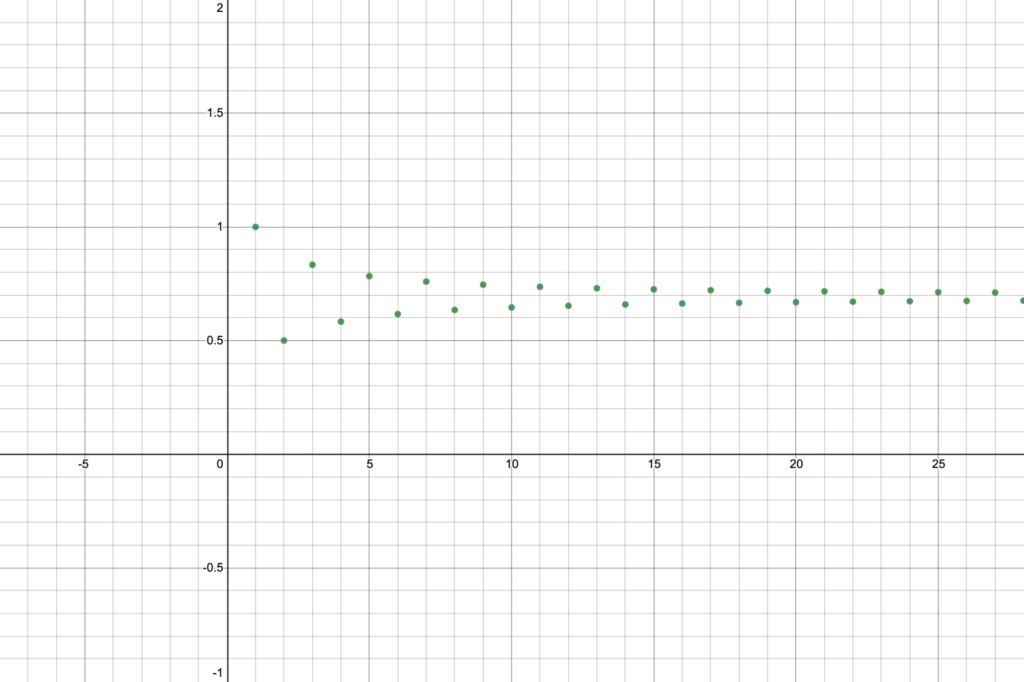Welcome back! In this lesson we’ll add another test to our series convergence/divergence toolbox. After this lesson, we’ll introduce the last tests for the toolbox in the next lesson.

Lesson 17: Alternating Series
Learning goals:
- Use the alternating series test to test an alternating series for convergence.
- Explain the meaning of absolute convergence and conditional convergence.
Topic:
- Volume 2, Section 5.5 Alternating Series (link to textbook section)
WeBWorK:
- Series – Alternating Series
Motivating question
Many of the tests in our series convergence/divergence toolbox assume that all the terms in a given series or positive. These tests can also be used when all the terms are negative. But most series have terms of different signs. One special way for a series to have terms of different signs is when they alternate. So what can these alternating signs tell us about the convergence or divergence of a series?
Determine the first few partial sums of the following series.
\[1- \frac{1}{2}+ \frac{1}{3}-\frac{1}{4}+\frac{1}{5}- \frac{1}{6}+\frac{1}{7} \dots\]
Using the sequence of partial sums, guess whether the series converges or diverges.
We begin by determining the first few partial sums. We’ll find as many as we think we need to to notice a pattern
- $S_1 = 1$
- $S_2= 1-\frac{1}{2} = \frac{1}{2}$
- $S_3 = 1-\frac{1}{2}+\frac{1}{3} = \frac{5}{6}$
- $S_4 = 1-\frac{1}{2}+\frac{1}{3}-\frac{1}{4} = \frac{7}{12}$
- $S_4 = 1-\frac{1}{2}+\frac{1}{3}-\frac{1}{4} + \frac{1}{5} = \frac{47}{60}$
- $S_5 = 1-\frac{1}{2}+\frac{1}{3}-\frac{1}{4} + \frac{1}{5} – \frac{1}{6}=\frac{37}{60}$
The second part of the question asks us to guess whether this sequence of partial sums converges or diverges. It’s not exactly clear when the terms are given as fractions, so we convert them to decimals (and round) to see that the sequence is:
\[ 1, 0.5, 0.83333, 0.58333, 0.78333, 0.61666, \dots\]
It might be a bit more obvious now that the terms are bouncing above and below a certain fixed value (though it might not be clear what that value is yet), and they’re getting closer and closer to that value. This suggests that the sequence of partial sums converges, which would mean that the original series converges as well.
Motivating example
Beginning with Warmup exercise 1, we’re getting a sense that the alternating harmonic series
\[\sum_{n=1}^\infty (-1)^{n+1}\frac{1}{n} = 1- \frac{1}{2}+ \frac{1}{3}-\frac{1}{4}+\frac{1}{5}- \frac{1}{6}+\frac{1}{7} \dots\]
might converge. This might seem surprising because we know (using the integral test for example) that the harmonic series
\[1 +\frac{1}{2}+ \frac{1}{3}+\frac{1}{4}+\frac{1}{5}+ \frac{1}{6}+\frac{1}{7} \dots\]
diverges. So adding a sign so that the terms alternate between positive and negative makes a big difference. To strengthen our intuition for this example, let’s plot the terms in the sequence of partial sums. Figure 1 below shows a graph of the first several partial sums. Click on Figure 1 to open up an interactive Desmos graph (link here as well). Use the slider for $b$ in the upper left of the screen to drag the red horizontal line up and down until it looks like the green plotted points will converge to that line as the number of terms approaches infinity. At what height is your red horizontal line?

After we’ve seen Taylor Series in Lesson 20, it will be very easy for us to show that the alternating harmonic series converges to $\ln(2)$.
Alternating series test
Here are some facts to keep in mind, based on what we saw in previous lessons, in today’s Warmup exercise 1, and in today’s motivating example.
- In order for a series to even have a hope of converging, its individual terms must approach zero (consider the Divergence Test from Lesson 15).
- But just because the individual terms of a series tend to zero doesn’t mean that series will converge (consider the harmonic series $\sum_{n=1}^\infty \frac{1}{n}$…its terms approach zero, but the series still diverges).
- In our motivating example, we saw that taking a positive, decreasing series where the terms approach zero, then forming a new series by alternating the signs, gave us a new series that converged! This is the upshot of the alternating series test.
Theorem (Alternating series test): Assume that $\sum_{n=1}^\infty a_n$ is a series where
- $a_n\geq0$ for all $n$,
- $a_n \geq a_{n+1}$ for all $n$,
- $\lim_{n \to \infty} a_n =0$.
Then the two alternating series $\sum_{n=1}^\infty (-1)^n a_n$ and $\sum_{n=1}^\infty (-1)^{n+1} a_n$ both converge.
The alternating series test applies to our motivating example: the alternating harmonic series $\sum_{n=1}^\infty (-1)^{n+1} \frac{1}{n}$ because the individual terms satisfy the three conditions:
- $n > 0$ so $\frac{1}{n} > 0$ for all $n$,
- $n < n+1$ so $\frac{1}{n} > \frac{1}{n+1}$ for all $n$,
- $\lim_{n \to \infty} \frac{1}{n} = 0$.
So the alternating harmonic series $\sum_{n=1}^\infty (-1)^{n+1} \frac{1}{n}$ converges by the alternating series test.
Video 1 below shows us how to apply the alternating series test to the motivating example again, as well as to a few other examples.
Notice that if $\sum_{n=1}^\infty a_n$ is already convergent series where all the terms are positive, then the corresponding alternating series $\sum_{n=1}^\infty (-1)^n a_n$ or $\sum_{n=1}^\infty (-1)^{n+1} a_n$ will converge by the alternating series test.
Absolute and conditional convergence
If you have a series positive $\sum_{n=1}^\infty a_n$ that converges, then the corresponding alternating series $\sum_{n=1}^\infty (-1)^n a_n$ converges in a very strong sense. It “super extra converges.” That just means that it doesn’t rely on the alternating signs to converge. We want to separate this strong sense of convergence of a series from a weaker one which requires the alternating signs.
Definition: Let $\sum_{n=1}^\infty a_n$ be a series.
- If $\sum_{n=1}^\infty |a_n|$ converges, then $\sum_{n=1}^\infty a_n$ converges absolutely.
- If $\sum_{n=1}^\infty a_n$ converges but $\sum_{n=1}^\infty |a_n|$ diverges, then If $\sum_{n=1}^\infty a_n$ converges conditionally.
This means that there are three possibilities for any given series:
- the series converges absolutely,
- the series converges conditionally, or
- the series diverges.
Example: In the case of the alternating harmonic series from our motivating example above, the series $\sum_{n=1}^\infty (-1)^{n+1}\frac{1}{n}$ converges by the alternating series test. But it does not converge absolutely because $\sum_{n=1}^\infty \frac{1}{n}$ diverges (see Lesson 15 here). Therefore, the series $\sum_{n=1}^\infty (-1)^{n+1}\frac{1}{n}$ converges conditionally. Video 2 below shows this in more detail.
The following theorem may seem obvious to you because of the language, but we still need to be explicit:
Theorem: If the series $\sum_{n=1}^\infty a_n$ converges absolutely, then it converges.
So there are two kinds of convergence (absolute and conditional) but only one kind of divergence.
Examples
Video 3 below shows the convergence (conditional or absolute) or divergence of three different series, each using different convergence tests.
Videos 4 and 5 below each show one more example of the convergence (conditional or absolute) or divergence of another series.
Additional Video Resources
Determine whether the series converges conditionally, converges absolutely, or diverges.
\[\sum_{n=1}^\infty \frac{10}{7n+2}\]


